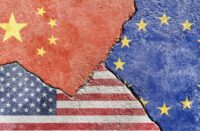The future of the United States Agency for International Development (USAID) has been a topic of intense discussion since President Donald Trump’s return to office. This independent entity, established by President John F. Kennedy in 1961, was created to counterbalance Russian influence through American development and aid programs. USAID has primarily concentrated on disaster and poverty relief, global technical cooperation, such as environmental issues, as well as U.S. bilateral interests and socioeconomic development, with many of these programs executed in the Asia-Pacific region.
However, in recent times, USAID has faced increasing criticism, viewed as antiquated and ineffective. Accusations have been made that it supports international elites, is involved in money laundering, and funds a “censorship-industrial complex”. Questions have been raised about its use of aid as a political tool to manipulate other countries, wasteful spending on projects that don’t align with U.S. national interests, and questionable aid funding practices. The agency’s reliance on private entities or NGOs for program delivery has also sparked debates about potential political influence in contractor selection.
Despite the criticism, USAID’s contributions to high-impact programs cannot be ignored. These include emergency response assistance in times of natural disasters and political instability, support for the removal of unexploded ordnances, provision of medication and testing for HIV/AIDS, basic healthcare support, and initiatives targeting maternal and child health.
The U.S. allocates 0.3 percent of its GDP to aid, and USAID’s budget has seen significant growth since 2019. With a workforce of 10,000, two-thirds of whom work overseas, USAID’s funding is determined by the U.S. Congress based on administration requests. However, only 12 percent of these funds go to local organizations in foreign countries, while the majority is funneled to international organizations and companies, most of which are U.S.-based. This points to high operational costs including salaries, benefits, overseas missions, training, security, and information technology.
The Trump administration is pondering over the future of USAID. Secretary of State Marco Rubio has hinted at the possibility of integrating it into the Department of State. This approach has been adopted by other countries, including Australia, New Zealand, and Canada, who have merged their development aid into government agencies to better align aid with foreign policy interests.
However, this decision isn’t without drawbacks. The mergers in Australia and Canada were met with initial confusion and uncertainty. Australia’s surprise decision to merge its independent aid agency into the foreign affairs ministry was driven by the perception that aid programs had strayed from national interests.
Despite the initial hiccups, the mergers in Australia, New Zealand, and Canada have yielded benefits. They have led to cost savings, improved alignment with foreign policy, and increased effectiveness of roles in developing countries. However, the mergers also led to a temporary decline in aid expertise as experienced aid practitioners left government jobs or moved to other roles.
If the Trump administration decides to merge USAID operations into the State Department, it’s vital to ensure that high-value programs and the specialists overseeing them are preserved and transitioned into the State Department as swiftly as possible. Lessons can be learned from the experiences of Australia, New Zealand, and Canada to minimize disruption and to establish a more efficient and cohesive operational approach.




